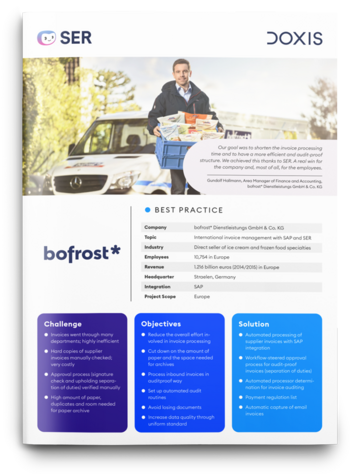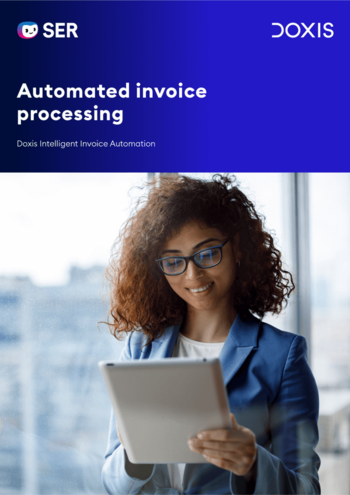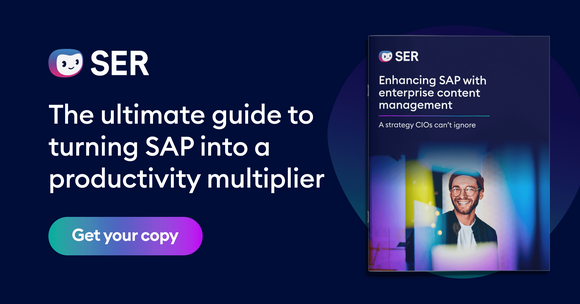SER Blog Customer Stories & Use Cases
Adapting to EN 16931: A guide for UK businesses
Gary Crowther
As the European Union rolls out its VAT in the Digital Age (ViDA) initiative, a sweeping transformation is set to impact how businesses manage and report value-added tax (VAT). Central to this reform is the EN 16931 standard, which mandates electronic invoicing as part of a broader push for digital reporting, set to become compulsory for many EU member states from 2024. This move aims to streamline VAT processes, reduce fraud and strengthen the digital economy across the EU.
But what about UK enterprises trading with the EU? While there’s no domestic law mandating compliance with ViDA, the changes cannot be overlooked. British enterprises interacting with EU counterparts will find it necessary to adapt to these changes if they wish to maintain smooth trading and business relationships. And while compliance is a leading issue here, it’s also a golden opportunity to step closer towards digital transformation.
So, let's unpack what EN 16931 entails, examine the imminent changes and discover how UK businesses can both adapt and thrive by embracing these new invoicing standards.

Setting the scene: Europe’s invoice digitalization
The EU’s proactive stance on enhancing its digital infrastructure is vividly embodied in the VAT in the Digital Age (ViDA) initiative. This ambitious program is set to revolutionize how businesses across the EU manage and report value-added tax, heralding a new era of fiscal transparency and efficiency. At the core of ViDA is EN 16931, the mandate for eInvoicing and digital reporting that is scheduled to take full effect by 2028, though there’s talk it could be postponed to 2030.
But EN 16931 is way more than just a procedural lurch into the future — it’s a strategic overhaul designed to curb VAT fraud and simplify the cross-border transactions that are commonplace in the EU’s single market. By requiring that all invoices be processed electronically, the EU aims to ensure that data on goods and services exchanged within its borders is accurate, timely, and most importantly, traceable in real-time.
There’s lots to be excited about if you’re an EU organization. A cursory glance alone will highlight the potential for enhanced operational efficiency, with eInvoices poised to:
- Dramatically speed up the billing process
- Reduce human errors made through manual processes
- Lower the costs associated with paper invoicing
- Make it easier for businesses to comply with EU regulations, thanks to the digital trail created by eInvoicing
- Inform strategic decision-making, as digitalization means more readily available access to valuable data
If you want to go deeper into what’s happening in Europe, check out ViDA: What the EU’s VAT reform means.
Great, but what about you Brits across the Channel?
If you’re a large enterprise that happens to find itself irreversibly British, you might be wondering how exactly these changes will impact you. Well, they can and will. Demand for compliance won’t arrive via a strongly worded letter from Keir (since there’s no bill sat languishing in Parliament for eInvoicing), but your customers and partners in the EU do expect you to fall in line.
Yep, compliance is practically unavoidable if you wish to stay in their good books. They’ll expect you to meet their requirements, just as everyone else is doing, and you can bet your last quid their accounting departments won’t make exceptions. Once they have their eInvoicing process in place, that will be it for the foreseeable future, or until the next piece of legislation makes them hop, skip, and jump. Best to get ahead of it now!
This doesn’t have to be a ‘ugh, fine’ moment, though. On the contrary, it’s worth seeing this as a strategic move that can position your organization favorably in a rapidly digitalizing market, and perhaps more importantly, finally provide that much-needed push towards digital transformation. By adopting the same invoicing standards as your EU counterparts, you can:
- Automate data entry and validation for invoices, reducing human errors, leading to faster processing times
- Enhance invoice tracking and compliance, providing real-time visibility and adherence to international regulations with standardized formats
- Reduce operational costs by eliminating expenses related to paper invoicing, such as printing, postage and storage
- Boost security and analytical capabilities, using electronic verification to minimize fraud risks and integrating with business intelligence tools for deeper insights into financial operations
- Improve payment cycles and business relationships, ensuring quicker payments and reliable, timely billing communications with customers and suppliers
But first, to achieve any of the above, you need to understand what exactly your EU customers and partners are expecting when they receive an eInvoice.

The EN 16931 standard: Core elements and compliance
EN 16931 establishes a core invoice data model, which defines the semantic structure of an eInvoice. This model is designed to ensure that all eInvoices are uniform and comprehensible across different systems and member states, which means easier processing and integration – and fewer headaches for a finance department.
Semantic data model
This model specifies the mandatory information that must be included in an eInvoice and standardizes the terminology used, ensuring that the data is understood consistently across all EU countries. This includes details like transaction dates, amounts, tax calculations, and party identifiers, which need to be presented in a structured format that machines can process without ambiguity.
Syntax binding
The standard allows for the semantic model to be implemented using different syntaxes, primarily UBL (Universal Business Language) and UN/CEFACT CII (Cross Industry Invoice). These syntaxes describe how the data elements in the semantic model should be formatted and transmitted electronically. This flexibility helps accommodate various technological frameworks while maintaining a standardized approach.
Compliance levels
To comply with the EN 16931 standard, businesses must meet three levels of compliance:
- Invoice document compliance: Every electronic invoice must adhere to the defined core invoice model or any relevant Core Invoice Usage Specification (CIUS) that further specifies certain use cases or national requirements.
- Implementation compliance: Entities receiving eInvoices must be capable of processing invoices that conform to the standard or an applicable CIUS. Similarly, entities issuing invoices must ensure their systems can generate invoices that meet these standards.
- Specification compliance: If using a CIUS, it must conform to the core rules of the EN 16931 standard without deviation, ensuring interoperability.
Now, if you’re someone who deals with invoices on a regular basis, the information above should make perfect sense. But if not, and this is all coming across as a load of technobabble, we get it. Basically, it's about ensuring your invoice process—how you send, receive and process invoices—meets specific standards (EN 16931). You'll need to check that your invoices include certain details, like dates and amounts, in a standardized way that everyone across the EU can understand, kind of like making sure your turn signals are understood whether you're driving in London or Lisbon.

bofrost*: Automated inbound invoice processing with ECM & SAP
Read all about how bofrost* automates its invoice processing with Doxis, saving time and money along the way
Read nowHow long do you have to meet the EN 16931 standard?
Roughly speaking, if you're a UK business trading with the EU, you should start reviewing your eInvoicing capabilities now. With various EU countries rolling out mandatory eInvoicing in stages, preparing will ensure you're not caught off guard as these requirements become enforceable. Here’s what’s happening for Germany, France and Italy, for instance:
Germany's progressive rollout:
January 2025: Starting in January 2025, Germany will begin a phased implementation of mandatory eInvoicing for B2B transactions. This initial phase gives businesses a grace period to adapt their systems and workflows to comply with new eInvoicing requirements. This period is especially beneficial for UK businesses operating in Germany, as it allows them to test their systems and ensure they are fully compliant with the new regulations before any enforcement begins.
France's phased approach:
September 2025: Large and medium-sized companies in France must start using eInvoicing. This is quite soon, so you can expect some emails from any French customers (or service providers if you’re the customer) asking you to get with the times.
September 2026: The mandate extends to all companies, culminating in full compliance by September 2026. This phased approach gives UK businesses a clear timeline to prepare and scale their solutions.
Read more about it in France's 2026 eInvoicing requirement: what you need to know.
Italy's early adoption:
January 2024: Starting in January 2024, Italy mandated that all businesses, regardless of size, must use the eInvoicing system Sistema di Interscambio (SdI) for all transactions. This includes both domestic and cross-border invoicing. The invoices must be in the standardized FatturaPA XML format and include a qualified digital signature to ensure authenticity. Additionally, technical updates introduced in February 2024 require businesses to incorporate new coding and validation checks into their eInvoicing processes. Failure to comply can result in penalties ranging from €250 to €2,000 per invoice.
What are your concrete next steps as a UK enterprise?
The journey towards aligning with the EN 16931 standard begins with a meticulous evaluation of your current invoicing setup. Key areas to focus on include:
Technological review:
Assess whether your existing invoicing software can handle the formats required by the EU, such as the previously mentioned UBL (Universal Business Language) or UN/CEFACT CII (Cross Industry Invoice). This will likely involve consultations with your IT department or software providers to understand the capabilities and limitations of your current systems.
Process evaluation:
Understand the flow of your invoicing process from creation to payment. This includes mapping out how invoices are generated, sent, received, and stored. Look for any manual processes that could be automated and examine the current error rates in invoice processing to identify improvement areas.
Integration capability:
Check how well your invoicing system integrates with other business systems like ERP (Enterprise Resource Planning), CRM (Customer Relationship Management), and supply chain management solutions. Effective integration is essential for automating processes and ensuring data consistency across platforms.
Compliance readiness:
Apart from technical capabilities, assess your system’s ability to meet legal and regulatory requirements. This includes data security measures, archiving capabilities, and compliance with international standards beyond eInvoicing, such as data protection regulations.
Chat with your partners:
There’s a strong chance that the people you’re doing business with across the EU will write to inform you of policy changes regarding invoicing. The email will likely explain everything you need to know about complying with their requirements.
The most important next step is readying for digital transformation
EN 16931 is but one small echo of a call to action that is sounding across the business landscape, pushing enterprises towards digital transformation. And whether you’re a holdout clinging to the fading value of a dated legacy system or a digital native with their finger on the pulse of the latest tech, the flags of change are reigning high, and that’s good. EN 16931 and ViDA comprise one small slice of a big, juicy pie called the digital future, crammed full of ingredients like automation and AI. But it’s crucial that businesses start reining in the tempest of folders, files and information scattered across the average business’ IT environment.
eInvoices alone are a major contributor to this bloat, but they're far from the only culprits. Think about the entire ecosystem of documents. Here’s just a sliver of them:
- Contracts
- Financial reports
- Purchase orders
- Payment receipts
- Compliance reports
Each of these documents adds layers to an already towering pile that needs to be processed, understood, managed and archived.
Now, fold in the complexities of regulatory compliance and international transactions and the picture gets even denser. Each document type, while a cog in the broader machinery of your business processes, brings its own format, data standards and retention rules. Without an intelligent content automation platform, this can quickly spiral into chaos.
This is where the excitement around going digital becomes palpable. Imagine replacing the cluttered file cabinets and server folders with a digital system that organizes everything in one place and uses AI to transform your documents into actionable insights. We're talking the calibre of software that automates data capture, flags discrepancies instantly and makes your stored information easily accessible, turning it into a valuable resource for strategic decision-making.
Manage inbound eInvoices easily with Doxis
SER's Doxis Intelligent Invoice Automation is the optimal choice for effortlessly processing the wave of inbound eInvoices you’re destined to receive from your EU counterparts thanks to EN 16931. It provides a comprehensive solution for digital inbound invoice processing that automates the entire inbound workflow, from receipt to archiving. The system captures invoice data, verifies it and then processes it according to pre-set criteria.
With deep integration into ERP systems, Doxis allows for same-day processing of thousands of invoices, ensuring compliance and transparency across all steps. The software also supports mobile access, enabling invoices to be approved anytime, anywhere. With Doxis you’re looking at a significant reduction in manual workloads, lower error rates and overall better efficiency in invoice management, all while ensuring audit-proof archiving.

Manage inbound eInvoices easily with Doxis
SER's Doxis Intelligent Invoice Automation is the optimal choice for effortlessly processing inbound invoices from your EU counterparts, no matter the format. Get the details in this free brochure.
Get the free guideWhy leading enterprises swear by Doxis Intelligent Invoice Automation
- Compliance:
Doxis is designed to meet stringent domestic and international legal requirements for invoice processing and archiving. The system's audit-proof archiving ensures that all business documents, including invoices, are stored securely and in accordance with regulatory standards until the end of their legal retention period. Doxis also checks the formal requirements and content of all invoice formats—whether PDF, CSV, EDI, or paper mail—ensuring that each invoice meets compliance criteria before processing.
Still need a bit of convincing on Doxis and compliance? Check out these reasons why you need a certified platform like ours.
- Increased efficiency:
Doxis automates the entire invoice processing workflow, from data capture to posting, significantly reducing the time and manual effort required. The system allows for same-day processing of thousands of invoices, saving around 50% of the time per invoice.
- Error reduction:
The system’s advanced OCR and verification features ensure that invoices are captured accurately and that any discrepancies are flagged immediately, reducing the risk of errors that can lead to costly delays or mistakes. - Seamless Integration:
Doxis integrates deeply with ERP systems, including SAP, and supports a wide range of invoice formats and currencies. This integration ensures smooth data transfer and processing, enhancing the overall workflow. - Resource optimization:
Automation of manual tasks with Doxis allows businesses to deploy resources more efficiently, avoiding bottlenecks and delays in processing invoices. - Enhanced profitability & liquidity planning
By speeding up the posting of inbound invoices and reducing errors, Doxis helps businesses secure cash discounts and improve overall profitability. The solution also provides complete transparency over the status and amounts of all invoices, enabling better and more up-to-date liquidity planning. As one customer from Aareal Bank said, “Before electronic inbound mail and invoice processing was initiated, invoices sometimes took longer than three weeks to be processed and they were no longer legible for cash discounts. We launched a centralized ECM platform with the goal of creating order, transparency and auditability within our corporate document-based processes. With Doxis, we've reached this goal."

Aareal Bank: Efficient & compliant real estate financing
Read all about how the cross-location Doxis ECM platform enhances process efficiency in real estate financing
Read nowNext steps: Getting ahead of the curve
This big change happening across the Channel is, on the surface, a rightful leap towards streamlining operations and paving the way for enhanced efficiency across all business practices, but its core is far more exciting. It stems from a vision of a business landscape where the sluggish is replaced with something swift and easy that gives you more time to focus on parts of your job that provide genuine value. Nobody wants to sit in front of a pile of invoices ripe for processing, surely. Or maybe you do, in which case, there’s still a way to do it faster and with less effort.
EN 16931 is just one puzzle piece of an inevitable transformation that is awaiting all of enterprises. And if you ask us, we’d tell you to use this time to get ahead of the curve and start looking for an intelligent content automation platform that suits you best.
Why not start right here? Reach out! Our experts can guide you through everything we’ve discussed. After all, SER has been helping leading brands like DHL, SEW-Eurodrive and Helvetia achieve truly some remarkable results, for decades. It’s what we do best.
Gary Crowther
Hello! I’m Gary Crowther, your go-to EN Content Writer and Storyteller at SER, where I transform facts and statistics into narratives that everyone can grasp and act upon. Off the clock, I can be found gaming, hiking, devouring novels and watching films.

The latest digitization trends, laws and guidelines, and helpful tips straight to your inbox: Subscribe to our newsletter.
How can we help you?
+49 (0) 30 498582-0Your message has reached us!
We appreciate your interest and will get back to you shortly.




